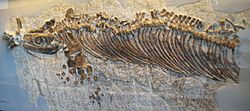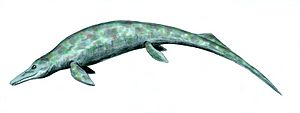Cymbospondylus facts for kids
Quick facts for kids CymbospondylusTemporal range: Middle – Upper Triassic
|
|
|---|---|
 |
|
| Cymbospondylus fossil | |
| Scientific classification | |
| Kingdom: | |
| Phylum: | |
| Class: | |
| Subclass: | |
| Superorder: | |
| Order: | |
Cymbospondylus was a huge, ancient sea reptile. It lived during the Triassic period, both in the Middle and Upper Triassic times. This amazing creature was a type of ichthyosaur, which means "fish lizard."
It had a long body, much like an eel, and could grow up to 10 meters (about 33 feet) long! That's longer than a school bus. Fossils of Cymbospondylus have been found in places like Germany and Nevada, USA. This suggests it swam across vast oceans, just like big marine animals do today.
Contents
About Cymbospondylus
Cymbospondylus was one of the biggest ichthyosaurs ever. Its fossils show it could be from 6 to 10 meters (20 to 33 feet) long. Even though it was an ichthyosaur, it didn't look much like a fish. It didn't have a dorsal fin (the fin on its back) or a fluked tail (like a whale's tail).
However, it did have a long snout, just like many other ichthyosaurs. Its head was about one meter (3 feet) long! This head had big jaws filled with rows of teeth. These teeth were perfect for catching and holding onto slippery prey.
What Cymbospondylus Ate
Cymbospondylus was a skilled hunter. Its diet mainly included fish, belemnites (ancient squid-like creatures), and cephalopods like ammonites. Its long, powerful tail was excellent for swimming. It helped Cymbospondylus move very fast. This speed allowed it to chase down schools of fish and other quick prey.
Adult Cymbospondylus likely spent most of their time hunting in deep ocean waters. They probably only came into shallow areas to have their babies or to find food that was only available at certain times of the year.
How Cymbospondylus Lived
Like other ichthyosaurs, Cymbospondylus probably gave birth to live young. This means they didn't lay eggs, because they lived entirely in the water. Once the young Cymbospondylus grew to adult size, they likely had very few, if any, predators that could harm them.
The eel-like tail of Cymbospondylus was very long. It made up almost half of its entire body length. This long tail was probably its main way of swimming. Just like modern sea snakes, Cymbospondylus likely swam by wiggling its body from side to side through the water.
Images for kids
See also
 In Spanish: Cymbospondylus para niños
In Spanish: Cymbospondylus para niños




